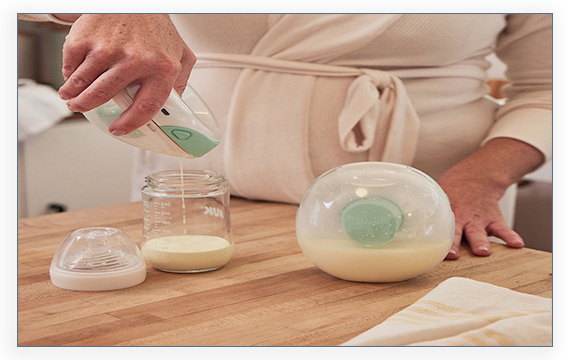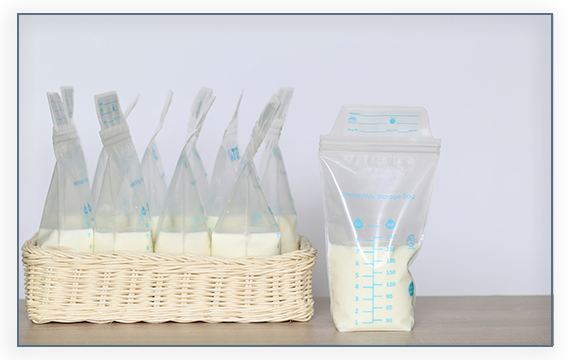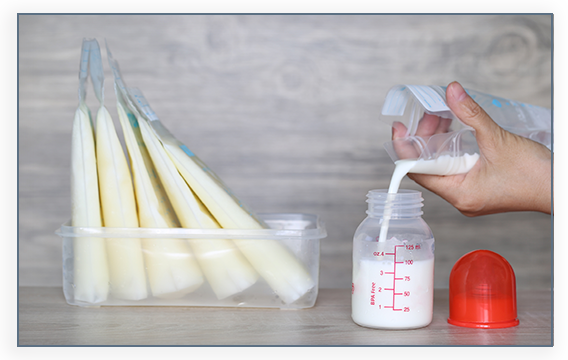Getting a Good Latch
The most important part of successful breastfeeding is the latch. If your baby is not properly latched on to your breast, feedings could be painful, and milk may not be transferred efficiently and effectively. This may make for longer, less successful feeding sessions and can impact milk supply long term.

Best time to breastfeed
• Try to nurse baby when he/she is in a REM sleep state (moving, eye movement, mouthing) or quiet alert state. Once baby is in an active alert state, you have some time to establish a calm relaxed feed, but once baby is crying it may be more difficult. During the crying state, cortisol levels increase, baby is stressed, and he/she may not be as successful in latching. To calm baby, try skin-to-skin contact and rocking.
• Look for feeding cues such as REM sleep, fist to mouth, and turning head toward breast.
Have more questions? Listen to our FREE podcast!
LISTEN NOWSteps to a good latch
• Sit in a comfortable chair with great back support, and use a stool to rest your feet. This will help maintain good posture and prevent you from straining your neck and shoulders.
• If you have one, use your breastfeeding support pillow. A good breastfeeding pillow can make a huge difference in getting baby in a proper position to latch.
• Make sure your baby is tummy-to-tummy with you at all times, and even skin-to-skin, if desired.
• Remember to keep baby’s ear, shoulder, and hip in alignment, which will make swallowing easier.
• The baby’s nose should be opposite the nipple (nose to nipple).
• You might need to hold your breast to help guide the nipple to baby’s mouth. Grasp the breast on the sides, using either a “C” hold or “U” hold. Keep fingers far from the nipple so you don’t affect baby’s ability to latch properly.
• Support baby’s back and neck, but allow his/her head to move back in order to properly latch.
• Baby’s mouth should be open wide at a 140 degree angle. You might need to rub the nipple across the top lip to get baby to open his/her mouth.
• You want baby at nipple level, but you shouldn’t have to bend over to achieve this. Aim your nipple slightly towards the roof of baby’s mouth, bringing baby to you, chin first.
• Make sure baby has a good seal with lips flanged out.
• Keep their nose and mouth close to your breast.
• Both your nipple and areola should be in baby’s mouth.
• Gentle tugging is normal. If the latch is uncomfortable or painful, gently place your finger in baby’s mouth, between gums, to detach and try again.
• Baby should have round/smooth cheeks when sucking.
• Baby’s jaw should be rocking back and forth and his/her ears should be wiggling.
• You will hear rhythmic swallowing.
Steps to a good latch
• Feeding should end with baby satisfied; his/her face and hands should be relaxed.
• Your nipple should not be misshapen; it may be slightly enlarged after nursing but if it is compressed, flattened, or lipstick shaped, this is an indication of an improper latch. This may result in painful, cracked, or sore nipples, and poor milk transfer.
The information contained here within is not intended to be a substitute for professional medical advice, diagnosis, or treatment. Always seek the advice of your physician or other qualified health provider with any questions you may have regarding a medical condition. Never disregard professional medical advice or delay in seeking it because of something you have read. If you think you may have a medical emergency, call your doctor, go to the emergency department, or call 911 immediately. Edwards Health Care Services (EHCS) does not recommend or endorse any specific tests, physicians, products, procedures, opinions, or other information that may be mentioned here within. Reliance on any information provided by EHCS, EHCS employees, contracted writers, or medical professionals presenting content for publication here within is solely at your own risk.
Sources:
• La Leche League: https://www.llli.org/breastfeeding-info/positioning/
• American Pregnancy Association: https://americanpregnancy.org/breastfeeding/latch/
Tags: Baby, Breastfeeding, Breastmilk, Infant, Latch, Mom, Newborn, Parent




